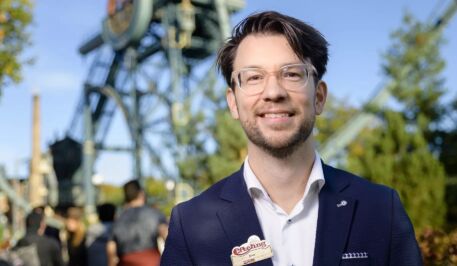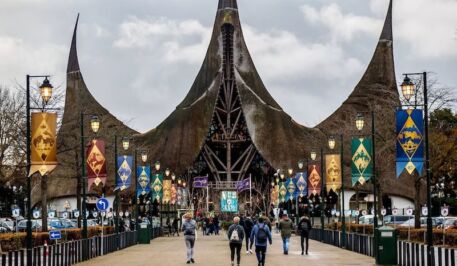The Efteling is the biggest amusement park in the Netherlands, and its goal is to have every visitor walk away with an experience that they would rate 9+. The park saw opportunities to use data and technology to deliver their guests an even more magical, day at the park: by reducing the waiting times at the most popular attractions and giving visitors a better view to how crowded the park is, and where the crowds are, at any given time. “Our mission is to give people a chance to escape the grinds and routines in their everyday lives,” the Efteling says. “We do that by making enchantment our priority. Everyone knows that waiting in line is going to be part of any visit to the park, but we can keep the waiting times as short as possible with the help of data-driven applications.”
Now, when you visit the park, at the start of your visit you can see how busy all your favorite attractions are expected to be throughout the day, thanks to a smart combination of data: things like visitor numbers, weather conditions and even the dates of school holidays across the country. Visitor surveys showed the Efteling that long lines are the number one reason cited by people who had complaints about their Efteling visit. So the park decided it was time to do something about it. Together with a team of data scientists, Jonas Rietbergen (38) now develops smart data products that can make the predictions that benefit both the visitors and the park.
'It’s great to see that you can make data work for us, not only us as the Efteling but the visitors too.'

Predicting wait times, that sounds almost like you have a crystal ball. How exactly does that work?“
Everyone knows that waiting is just part of going to an amusement park, but it does take a lot of the fun out of your visit to the Efteling. Is there any way we can spread the visitors out more evenly? That was the big question for our Data & Insights Team. We had a feeling that there were very significant peaks in the waiting times for certain specific attractions at the same times. For example, a lot of people go to the rollercoasters in the morning because those are the attractions they want to be sure not to miss. But a feeling is not enough, we wanted to know for sure. To get that certainty, we developed a research app in collaboration with the Jheronimus Academy of Data Science in ‘s-Hertogenbosch.”
“Visitors were offered a free cup of coffee if they downloaded the app and gave permission for the use of their data for the research. They then used the app on their phones throughout their day in the park so that we could track where they were. Geo-fencing enabled us to see what routes they followed. And once we had all the data, it did indeed turn out that most people follow the same movement patterns: first to the rollercoasters, and then everything else. And so we saw that the people who followed a different pattern, like if they started with the Carnaval Festival – which is in an entirely different corner of the park than where most people start – were able to get a lot more out of their day. Based on the results, we were then able to construct a personal recommendation to advise visitors of what attraction they could best do at any given time. We launched this lab app in 2020; it analyses the composition of your party, where you are in the park, current waiting times and expected waiting times. It takes all that and produces a recommendation for the attraction that would be your best choice right now.
Did the visitors go for it?
“At first, the visitors told us that they experienced it as something like a magic 8-ball: like, ‘hocus pocus, the signs say you should go to… the Python!’ That made people ask why, and it seems that most of them thought it felt simply random. That’s why we then added an indication of the expected waiting times in an easy-to-understand graph, like Google does with stores in busy urban areas. Now you can see at a glance: if you go to the Python now, you’ll only have a 20-minute wait, but if you go any other time of the day it will be more than 30. That’s when we saw the level of acceptance of the recommendations immediately shoot up: from one in 10 visitors who accepted them to one in three. That’s the insight that sold us on making the expected waiting times available to everyone in the regular Efteling app, which we have been doing since the end of June 2022. Almost every group uses this app, and what did we find? Two-thirds of visitors had the feeling that they were getting more out of their day thanks to the app. And that was reflected in higher visitor satisfaction, which is ultimately our end goal. It’s great to see that you can make data work for us, not only us as the Efteling but the visitors too.”
A question to Peter Perebooms, founder of inQdo:
What would you say is the defining characteristic of your partnership with the Efteling?
“We know that the most important thing to the people of the Efteling is the visitor experience: everything from reserving the tickets to leaving the park and heading home, and everything in-between, has to be great. Availability and good performance of systems are fundamental requirements, but so is the innovation that enables you to take that little extra step for the visitors. So with all that, we are always facing new challenges in our partnership with the Efteling: that makes our partnership very inspiring. Over the past seven years we’ve been discovering together how to get more and more out of AWS for the Efteling, one step at a time. The Efteling’s AWS environment contains a vast amount of data and a treasure trove of information. Every step of the way we’ve grown together to get the most out of the platform.”
How did inQdo help you in developing the Efteling app?
“As you can imagine, we had all kinds of different data that we wanted to combine. The predictive model behind the app takes a whole lot of things into account: rain, vacation periods, temperature, composition of visitor groups, and lots more. So that data has to be always available and easy to combine, and most importantly in an app that always works right. For that we needed a really reliable service. inQdo has extensive knowledge of all the potential of AWS and can use that expertise to provide the custom work to set that up in the most cost-effective way possible. To be specific, they helped us set up our ‘data lake’: it’s basically a vast pool of data that has any possibly relevant information available and that everyone can call on to fish out the data they need. inQdo also helped us with AWS SageMaker, which is where you can run all your machine learning and algorithms. You can compose models and make everything machine learnable; this is the place where all the programming that results in the predictions happens. In a way, it’s the amusement park for the data scientists.”


